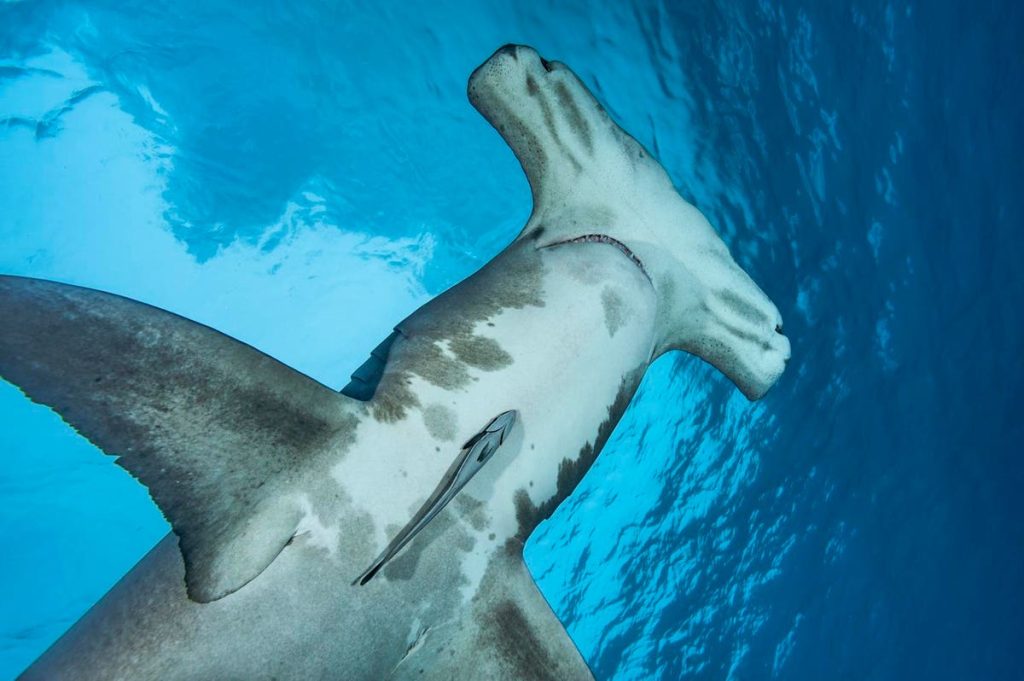Have you ever wondered why spotting a magnificent great hammerhead shark seems more likely during a full moon? Researchers in the Central Pacific Ocean have unraveled the pivotal role played by the lunar cycle in shaping the presence of these apex predators.
The great hammerhead (Sphyrna mokarran) is an iconic shark species, recognized by its distinctive T-shaped head that resembles a hammer. These formidable creatures inhabit warm tropical and subtropical waters around the world, often preferring the deeper regions of the oceans. With an average length of 13 to 20 feet (4 to 6 meters) and weighing up to a staggering 1,000 pounds (450 kilograms), great hammerheads are solitary hunters, feeding on a diverse menu of marine life, including fish, rays, squids, and smaller sharks. Equipped with extraordinary sensory adaptations, such as widely spaced nostrils for detecting odors and electroreceptors for sensing electrical fields, these sharks are master hunters. Unfortunately, great hammerhead sharks face significant conservation challenges due to overfishing, habitat degradation, and low reproductive rates, leading to their endangered status. Despite their role as important apex predators in marine ecosystems, these remarkable creatures require protection and conservation efforts to ensure their survival and maintain the ecological balance of our oceans.
A dedicated team of scientists conducted extensive underwater surveys, meticulously collecting data on 55 critically endangered great hammerhead sharks over several years at two Pacific atolls. Simultaneously, they diligently recorded the lunar cycle, tracking moon phases and calendar dates. Through rigorous statistical analysis, they unveiled consistent patterns linking shark sightings and behaviors to specific lunar phases or dates. Astonishingly, the full moon emerged as a key player, with peak shark sightings occurring just two days before its arrival. During the summer months of 2020 and 2021, a substantial number of these sharks were observed spending approximately six days each month at these specific sites, with their presence peaking before, during, and after the full moon. It’s almost as if these sharks have their very own lunar calendar! These findings led the researchers to conclude that the lunar cycle exerts a profound influence on great hammerhead shark movements, prompting speculation about the underlying reasons, such as heightened hunting activity during specific lunar phases.
Great hammerhead sharks possess a remarkable ability to sense changes in geomagnetic fields through specialized sensory organs known as ampullae of Lorenzini, located on their heads. While the precise mechanism remains a mystery, it is believed that during a full moon, subtle alterations in the Earth’s magnetic field may occur. These subtle changes could be detectable by the sharks’ ampullae of Lorenzini, enabling them to perceive variations in their surroundings. This heightened sensitivity during a full moon might aid them in navigation, prey location, or even coordinating behaviors in response to environmental shifts. One theory suggests that increased moonlight during a full moon enhances their hunting prowess, making it easier to spot prey. Nevertheless, further research is required to fully comprehend how great hammerhead sharks harness geomagnetic cues during different lunar phases.
One intriguing aspect of this study was the composition of the shark group: fifty-four of the sharks were identified as female, with the gender of one shark remaining undetermined. The research suggests that Rangiroa and Tikehau atolls serve as aggregation sites for great hammerhead sharks, despite their typically solitary nature. These sharks, although not interacting with each other, appear drawn to these locations due to external factors correlated with the lunar cycle and the presence of ocellated eagle rays (Aetobatus ocellatus). The research indicates that “the gathering of A. ocellatus is thus a predictable event that sharks could try to intercept, indicating that predation is a likely driving factor of the seasonal presence of great hammerhead sharks.”
While the separation of males and females within great hammerhead shark populations is a new observation, it has been previously documented in scalloped hammerhead sharks. The absence of males during this specific period hints at a potential link between these gatherings and the great hammerhead shark’s mating cycle. This season aligns with the identified parturition period for these sharks in the southern hemisphere. Moreover, lagoons and their protected warm-shallow-coastal waters are known to function as nursery areas for various shark species.
The precise reasons behind these gatherings remain unconfirmed, but these findings shed light on a critical site for these endangered creatures that requires protection for their survival and flourishing. The authors of the study emphasize, “The results of this study highlight the importance of these atolls for the conservation of great hammerhead sharks, where it still occurs in high numbers. Out of the 80+ atolls that compose the Tuamotu archipelago, at least 18 of them report great hammerhead shark sightings by fishers, inside or outside lagoons.”
Read the full article here









